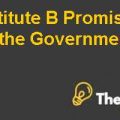
Traditional Approach to Employee Relation
Employee Relations
To elucidate the traditional approach to employee relations, first employee relations need to be understood. Employee relation is the communication or the contact sandwiched between the employees and management of the company by discussing the daily workplace decisions, issues, dilemmas, problem solving approaches and further problems related to collective bargaining. Maintaining the healthy employee relations always benefits the company. The reason for maintaining a tremendous relationship with employees is that it helps the company to overcome issue and routine business problems in an optimistic manner. When a management has good relations with employees so there is a huge chance that the issues and problems can be discussed openly and without any fear, which will result in solving the issue with a more appropriate approach. Furthermore employee relations are identified in history as industrial relations, which are responsible for the emotional, contractual, substantial and are practically applicable relationships between employee and their employer. The word employee relation is more and more used due to acknowledgment of the truth that a great deal of the relationship is in fact non-industrial. Some writers cite the employee relations as only concerned with non-unionized human resource and labor or manufacturing / industrial relations with unionized workforce. Some other proposes that these employee relations and industrial relations are dead grounds,which are substituted by the more all-encompassing Human Resource Management (HRM).
In the companies like coal mining and shipbuilding these approaches play a vital role because these industries have a massive flow of employees, which is followed by unions and other elected bodies. There massive role as a work force and united union bodies sometimes creates a great deal of hurdle for the company (James, 2005, 602). The beginning of these industrial relations comes ahead from the era of industrial uprising and the formation of free marketplaces and huge, united movements along with activities of workers. The resulting stress shoots up the need and shaped an urgent requirement for forces that can control and regulate the relationships. Historically employee relations, underneath the umbrella of industrial relationships were responsible for conflict management and looking after the enormously diverse agendas of employees and their employer. These days the expression is frequently used in a more collaborative manner and focuses at both the ways of employee along with employer that can get advantage from new proposals and schemes.
Progressively, there is the faith that the requirements of both employee and employer interlink, even though some businesses and intellectuals find it quiet difficult to settle the requirements of different businesses by working in an extremely competitive and free marketplace with those employees. It has also been observed that the employee relationship also differs from organization to organization because each and every organization has its own policies and rules of business that they follow as the part of their strategies. Lewis et al (2003, 4) advocated that these relationships can be differentiated by various factors that includes: the category of organization, the task that needs to be performed by the employee, location, overall rewards, most importantly those terms and condition of the employment relationship, deployment of power between employee and employers along with the effects regarding the employment relationships.
Approach to Employee Relations
Armstrong advocates that there are four major approaches to the employee relations. There are four diverse approaches to employee relations that includes: Adversarial Approach, Traditional Approach, Partnership Approach and Power Sharing.
Adversarial Approach
In this approach, an organization formulates its strategic decisions and decides that what needs to be done next and expects that employee will fit into it for sure. Employees can only show their powers by quieting from the job. As mentioned in the chapter, this Adversarial Approach is less common these days as compared to 1960’s and 1970’s. This approach bounds an employee to work as per an organization’s needs and wants. This approach has both the negatives and the positives aspects associated with it. In this approach, the rights of employees are protected for sure but the conflict between the unions and organization may shoot up. In the companies like coal mining and shipbuilding, Adversarial Approach may not be the best option because their huge number of employees may create a dead lock between the management and the employees of the company. (Robert et al, 2004, 169) suggested that in this approach the negotiations related conflicts are witnessed as battle. The powerful and more violent representative tastes the success and the weak one faces the loss. The approach paves the way towards competition and negotiations between representatives from the company and the employees.
In this approach the organization plans whatever they wanted to, most of the time these plans are made while ignoring the employee concerns and asks them to perform the desired task; which will sometimes result in increasing employees’ concerns over rules of business formulated by the organization. In the industry like coal .................................
This is just a sample partial case solution. Please place the order on the website to order your own originally done case solution.












